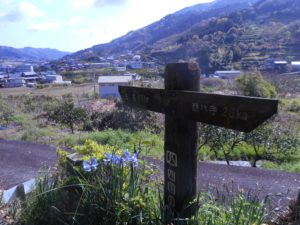The accidental pilgrim
I took a holiday in Japan the first two weeks of April 2019. At the heart of my trip was a five-day, four-night “self-guided tour” on Shikoku Island. The fourth largest island in Japan, it’s the home of the Shikoku Island 88 Pilgrimage, a route that for hundreds of years, Shingon Buddhist pilgrims have walked, visiting the 88 temples (a lucky number) around the perimeter of the island. The whole route is over 1,000 kilometers.

I gathered along the way that a full circuit takes three months or more to complete. Many temples have lodgings in them, and so do the towns along the way. In addition, a culture of caring for strangers pervades the area. Rest stops, free water and public toilets are everywhere, and there’s a practice, osetti, of giving money and food to pilgrims.
Pilgrims, known as O-Henro, are everywhere, wearing recognizable outfits. The full-on pilgrim uniform is white: leggings and a loose vest with black writing on it. A conical straw hat (great for keeping rain off) and traditional split-toed shoes that look amazingly comfortable. A white shoulder bag, also marked with black writing, for carrying prayer books and coins for offerings, and a book for collecting stamps at each temple office—a check off the list. And a walking stick, either plain or decorated with fabric, ribbons, and writing.
Most people I met on the trail wore at least a few elements of this outfit, and I spotted pilgrims at bus stations and in grocery stores even when I wasn’t on the trail. A few times, I used them to navigate. Just follow the white vest.
Together with the lush but rugged terrain—lots of small mountains and robust river systems—the presence of this walking population gives Shikoku Island an atmosphere of community and rigor. It’s definitely a spiritual place. I came there to hike, but I was surprised at the religious element I felt about along the way.